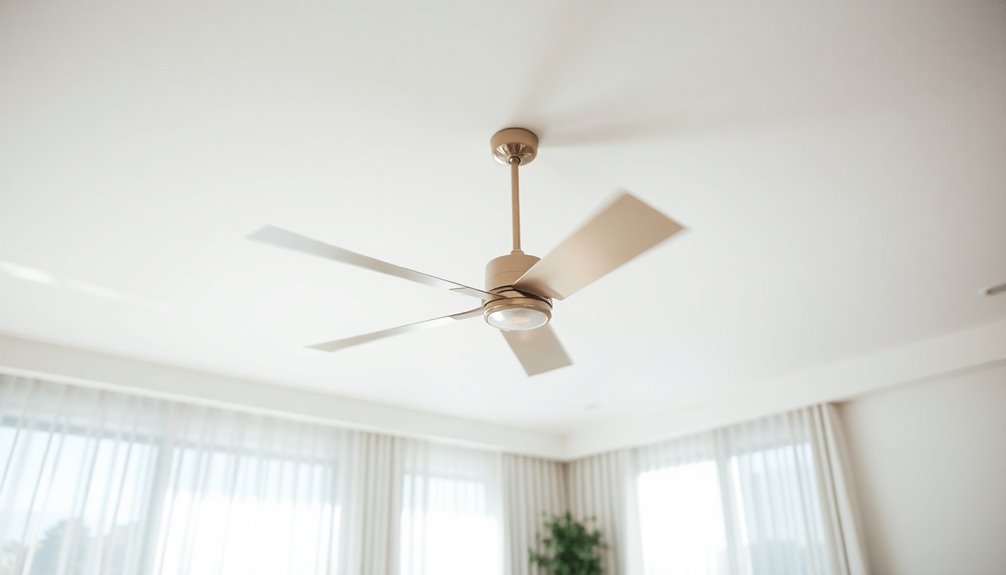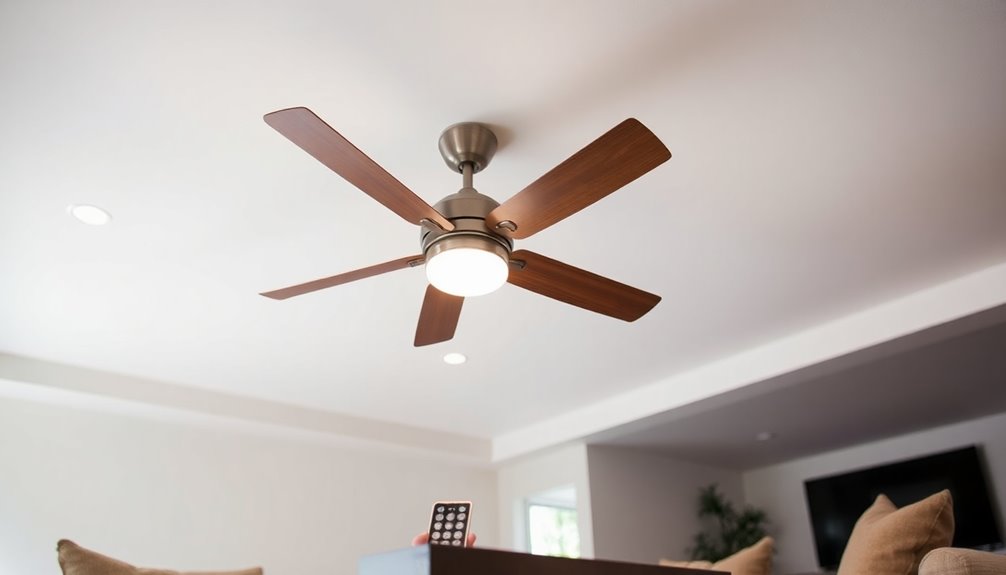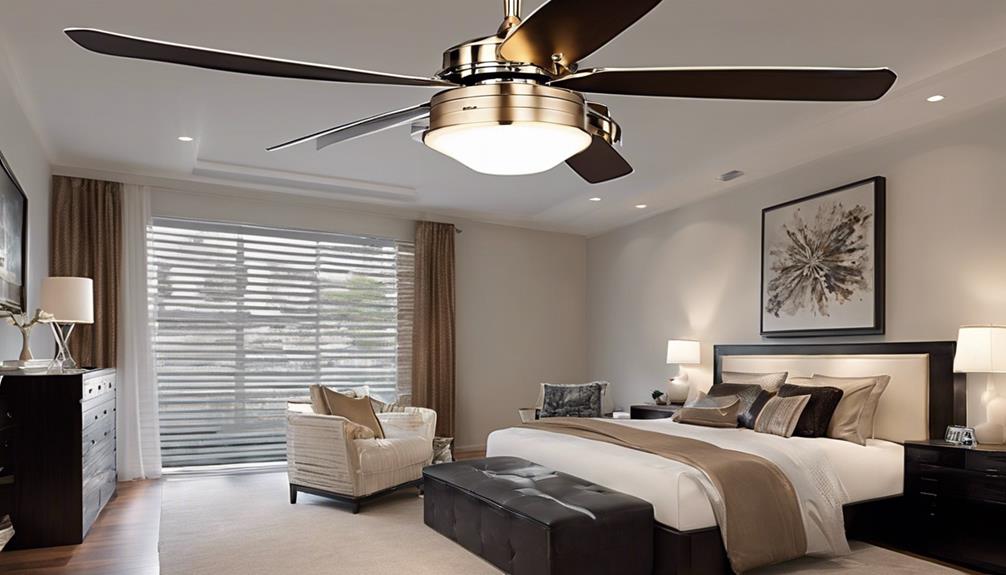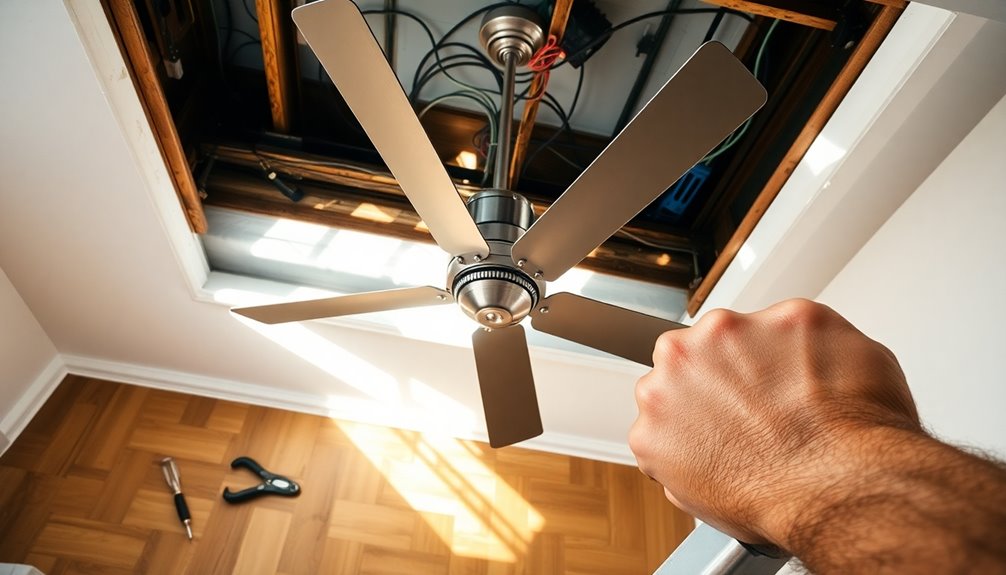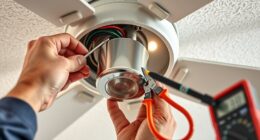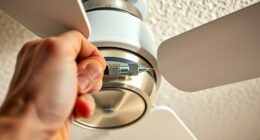You can run a ceiling fan continuously for over eight hours, which makes it perfect for providing consistent airflow and comfort. Most high-quality fans are equipped with safety features like thermal protection, ensuring safe operation even during extended use. Regular maintenance is key, so make sure to clean the blades and check for loose parts every few months. Not only do ceiling fans enhance indoor air quality, but they also offer an energy-efficient alternative to more power-hungry air conditioning units. Keep exploring to uncover more tips on maximizing your ceiling fan's performance and longevity.
Key Takeaways
- High-quality ceiling fans can operate continuously for 8+ hours without issues, thanks to their durable design.
- Built-in safety features, like thermal protection systems, prevent overheating during extended use.
- Regular maintenance, including cleaning and lubrication, enhances performance and longevity of continuous operation.
- Ceiling fans are energy-efficient, consuming significantly less power than air conditioning units during prolonged use.
- Unusual noises or performance issues during operation indicate a need for immediate maintenance or servicing.
Ceiling Fan Safety Features

When it comes to your ceiling fan's safety features, you can rest easy knowing that high-quality models are built with your protection in mind. These ceiling fans are engineered to guarantee safe continuous operation, often running for hours—sometimes up to eight or more—without any overheating risks.
One of the standout safety features is the thermal protection system, which automatically shuts off the motor if it exceeds safe temperature limits. This mechanism greatly reduces the risk of fire hazards in your home.
Additionally, reputable brands often boast safety certifications, like UL or ETL listings, which confirm their compliance with strict safety standards for electrical appliances.
Moreover, high-quality ceiling fans incorporate durable components, such as heavy-duty motors and reinforced wiring, which enhance their ability to function without malfunction during extended use. This durability can also contribute to lower energy bills, as efficient fans require less power to operate continuously.
To maximize safety and longevity, regular maintenance—like cleaning and inspecting electrical connections—is essential. By choosing a ceiling fan with these important safety features, you can confidently enjoy the cool air it provides, knowing your safety is a top priority.
Guidelines for Continuous Operation

Understanding the safety features of your ceiling fan sets the stage for knowing how to use it effectively for extended periods. Most high-quality ceiling fans can run continuously for about eight hours without any issues. Many homeowners even run their fans 24/7 during the hotter summer months for comfort.
You'll find that these fans are equipped with built-in safety features to prevent overheating, making it safe to leave them running.
To guarantee peak performance while your ceiling fan is running, regular maintenance is essential. Dust the blades and motor frequently to keep everything clean. This simple task helps maintain effective air circulation, especially during those extended periods of use.
Keep an ear out for any unusual noises or performance issues, as they can indicate maintenance needs. Addressing these issues promptly will guarantee your fan remains safe and efficient during extended use.
Benefits of Extended Use

Running your ceiling fan continuously offers several benefits that can greatly enhance your home's comfort and efficiency. One of the primary advantages is improved air circulation, which helps maintain better indoor air quality. By keeping the air moving, ceiling fans create a cooling effect that makes your space feel more pleasant without relying heavily on air conditioning.
Moreover, ceiling fans are a cost-effective cooling alternative, consuming only 15-90 watts compared to the over 3500 watts used by AC units. This significant difference in energy consumption translates to lower energy bills, especially during hot months.
You'll also appreciate the gentle breeze they provide, which can help improve your sleep quality by offering a soothing white noise that masks disruptive sounds. Additionally, using ceiling fans can complement your HVAC system, similar to how air purifiers significantly reduce allergens by enhancing overall indoor comfort.
Utilizing ceiling fans year-round, including reversing their direction in winter to push warm air down, enhances heating efficiency and comfort during colder months. Regular operation can also prolong the lifespan of your ceiling fans, ensuring they continue to circulate air efficiently.
Maintenance Tips for Longevity

Proper ceiling fan maintenance is essential for guaranteeing longevity and ideal performance. Regular care keeps your fan running efficiently and prevents unnecessary wear. Here are some simple tips to help you maintain your ceiling fan:
| Task | Frequency |
|---|---|
| Clean blades and motor | Monthly |
| Check for loose parts | Every 3 months |
| Lubricate moving components | Biannually |
| Turn off when leaving a room | Every time you exit |
Start by cleaning the blades and motor housing to remove dust buildup that can hinder performance and lead to overheating. Make sure your fan is installed at the recommended height of 2.1 to 2.7 meters to maximize efficiency and air circulation. Periodically checking for loose parts and lubricating components will reduce noise and extend the fan's lifespan. Additionally, maintaining efficient air circulation can help reduce the need for additional cooling methods, saving energy in the long run.
Don't forget to turn off the fan when you leave a room to save energy and lessen wear on the motor. Following manufacturer guidelines for maintenance schedules and cleaning practices will guarantee your fan operates safely and effectively for years to come.
Energy Efficiency Considerations

Ceiling fans are a cost-effective alternative to air conditioning, consuming between 15 to 90 watts, which is drastically less than the 3500 watts used by most AC units. This significant difference in energy consumption makes ceiling fans an attractive option for improving energy efficiency in your home. By ensuring your living spaces are organized and decluttered, you can help facilitate mindful energy usage and create a more peaceful environment. Additionally, using energy-efficient heat pumps alongside ceiling fans can further enhance your home's overall energy savings.
Moreover, choosing models with high CFM ratings can significantly improve air circulation and cooling efficiency in your space. Regularly cleaning your ceiling fans can prevent dust buildup, which can otherwise decrease their efficiency and impact indoor air quality.
However, running a ceiling fan continuously can increase your energy costs if it's left on when no one is in the room.
To truly maximize operational costs, consider investing in high-quality ceiling fans with Energy Star ratings. These models are designed to provide better airflow while consuming less power.
You can further optimize your energy usage by pairing ceiling fans with programmable thermostats, allowing you to maintain a comfortable environment without solely relying on your air conditioner.
Regular maintenance of your ceiling fans also plays an important role in energy efficiency. By ensuring they operate smoothly, you can minimize energy waste and prolong their lifespan. Additionally, understanding power requirements for gas lines can help ensure that your ceiling fan and other appliances operate safely and efficiently together.
Being mindful of how and when you use your ceiling fans will help you achieve the perfect balance between comfort and efficiency, ultimately keeping your energy bills in check.
Alternatives to Ceiling Fans

If you're looking for energy-efficient cooling options, there are plenty of alternatives to ceiling fans.
Smart home integration can enhance your comfort by automatically adjusting temperatures with programmable thermostats.
Consider bladeless fans or tower fans for effective airflow without the energy drain of continuous ceiling fan use. Additionally, using air purifiers can improve indoor air quality while keeping your space cool and comfortable.
Energy-Efficient Cooling Options
There are several energy-efficient cooling options that can serve as effective alternatives to ceiling fans. Exhaust fans, for instance, are a smart choice for kitchens and bathrooms, using less power while effectively circulating air.
You'll find they help maintain a comfortable environment without straining your energy bill.
Another option is a programmable thermostat. By automatically adjusting your home's temperature based on occupancy, it helps reduce cooling costs while keeping your space comfortable.
If you prefer a more modern approach, consider bladeless fans. They use internal blades to create airflow and are designed to be more energy-efficient than traditional bladed fans.
While air conditioning units tend to consume more energy, you can optimize their efficiency by using ceiling fans in tandem, allowing for higher thermostat settings without sacrificing comfort.
Additionally, look for Energy Star-rated appliances and smart home devices, as they considerably lower overall energy consumption when paired with traditional cooling methods.
Incorporating these energy-efficient options can provide effective cooling while keeping your energy costs in check, making your home comfortable without the unnecessary expense.
Smart Home Integration
Many homeowners are discovering the benefits of smart home integration as an alternative to traditional ceiling fans. Smart home systems can enhance your cooling experience by integrating with advanced cooling solutions like smart thermostats and air conditioning units. These systems allow for automated temperature adjustments based on occupancy and your personal preferences, ensuring ideal comfort with minimal effort. Additionally, high protein options like crab cakes can make for a great snack while enjoying your cooling solutions.
Smart ceiling fans, equipped with mobile app controls and voice command features, provide an added layer of convenience and energy efficiency. You can easily adjust their speed, direction, and scheduling to meet your specific needs. Additionally, the integration of smart lighting systems can further enhance the ambiance and comfort of your living space while reducing energy use.
Moreover, smart air purifiers not only improve indoor air quality but also circulate air throughout your space, making them a viable alternative to ceiling fans. Incorporating stress management techniques into your daily routine can further enhance your overall comfort and well-being.
Frequently Asked Questions
Is It OK to Run a Ceiling Fan 24 7?
Yes, it's generally okay to run a ceiling fan 24/7, especially during hot summer months.
These fans are designed for extended use, and most manufacturers don't restrict continuous operation.
However, you should consider turning it off when you don't need it to save energy and extend its lifespan.
Remember to perform regular maintenance, like dusting the blades, to guarantee it runs efficiently and safely.
Enjoy the comfort while being mindful of energy use!
How Many Days Can a Ceiling Fan Run Continuously?
Imagine your ceiling fan as a tireless guardian, tirelessly keeping your space cool. You can actually let your ceiling fan run for days without worry.
Many high-quality fans are built for continuous operation, often lasting years with minimal issues. However, keep an ear out for any strange noises or performance drops.
Can a Ceiling Fan Overheat?
Yes, a ceiling fan can overheat, especially if it's not properly maintained.
You should check for excessive heat or any unusual noises while it's running. If you notice these signs, turn it off immediately.
Regularly clean the blades and motor housing to prevent dust accumulation, which can cause overheating.
Most modern fans have safety features to protect against this, but it's always smart to stay vigilant for potential issues.
What Happens if a Fan Runs Continuously?
If you let a fan run continuously, it can generate heat, which is normal, but you should keep an eye out for signs of overheating.
Over time, extended use can lead to wear and tear, potentially shortening the fan's lifespan.
Regular maintenance, like cleaning and listening for unusual noises, is essential to guarantee it operates safely and efficiently.
Turning it off when you don't need it can also save energy and prolong its life.
Conclusion
Running your ceiling fan continuously is generally safe, but it's important to take into account maintenance and energy efficiency. You might worry about wear and tear, but regular checks and cleaning can keep your fan running smoothly for years. Plus, the benefits of consistent airflow and energy savings far outweigh the concerns. Embrace the comfort and efficiency of your ceiling fan, knowing that with a little care, it can enhance your space without hassle.
